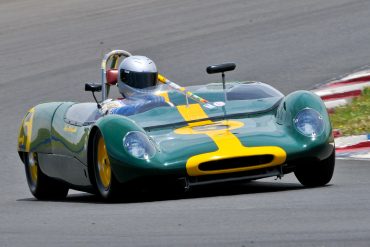Two-liter sports racing cars have always had a place to compete within the ever-changing regulations of international motorsports; the World...
Two-liter sports racing cars have always had a place to compete within the ever-changing regulations of international motorsports; the World...
Prices are based on an average of values submitted by our panel of expert consultants who this month include: Jack Boxstrom RM Auctions (613) 476-9132 Kent Bain Vintage Racing Services (203) 377-1658 Lance Coren Certified Appraiser (310) 370-4114 Chris Christansen Fantasy Junction (510) 653-7555 David Gooding RM Auctions (866) 762-8284...
Prices are based on an average of values submitted by our panel of expert consultants who this month include: Lance...
The Canadian American Challenge Cup (Can-Am) was co-sanctioned by the SCCA and CASC; it was a series nicknamed the “unlimited”...
The Canadian American Challenge Cup (Can-Am) was cosanctioned by the SCCA and CASC; it was a series nicknamed the “unlimited” series. Although there was a basic set of rules, the cars had to be two-seaters with bodywork covering the wheels, have doors, a windscreen and brake lights and meet various...
The Canadian American Challenge Cup was co-sanctioned by the SCCA and CASC—it was a series nicknamed the “unlimited” series. Although...
The Canadian American Challenge Cup was co-sanctioned by the SCCA and CASC—it was a series nicknamed the “unlimited” series. Although...
The Canadian American Challenge Cup was co-sanctioned by the SCCA and CASC—it was a series nicknamed the “unlimited” series. Although there was a basic set of rules, the cars had to be two-seaters with bodywork covering the wheels, have doors, a windscreen, brake lights and various safety requirements. However, there...
The Canadian American Challenge Cup was co-sanctioned by the SCCA and CASC, and quickly became known as the “unlimited” series....
The Canadian-American Challenge Cup was a series nicknamed the “unlimited” series co-sanctioned by the Sports Car Club of America and...
By almost anyone’s measure, one of the things that made the Golden Era golden was the Canadian-American Challenge Cup or the Can-Am. It was the pinnacle of American road racing. The cars were the ultimate in racing machines, to the extent that they were faster than Indycars and those running...
The Canadian American Challenge Cup was co-sanctioned by the SCCA and CASC—it was a series nicknamed the “unlimited” series. Although...
The Canadian American Challenge Cup was co-sanctioned by the SCCA and CASC—it was a series nicknamed the “unlimited” series. Although...
The Canadian American Challenge Cup, co-sanctioned by the SCCA and the CASC, was essentially an “unlimited” series. Although there was a basic set of rules, the cars merely had to be two-seaters with bodywork covering the wheels, doors, a windscreen, brake lights and various safety requirements. There was no regulation...
The Canadian-American Challenge Cup was co-sanctioned by the SCCA and CASC; it was a series nicknamed the “unlimited” series. Although...
The Canadian American Challenge Cup was co-sanctioned by the SCCA and CASC; it was a series nicknamed the “unlimited” series....
The Canadian-American Challenge Cup was an “unlimited” racing series co-sanctioned by the SCCA in America and the CASC in Canada. Although governed by a basic set of rules—the cars had to be two-seaters with bodywork covering the wheels, have doors, a windscreen, brake lights and various safety requirements—there were no...
The Canadian-American Challenge Cup was co-sanctioned by the SCCA and CASC; it was nicknamed the “unlimited” series. Although there was...
The Canadian American Challenge Cup was co-sanctioned by the SCCA and the CASC; it was a series nicknamed the “unlimited”...
The Canadian American Challenge Cup was co-sanctioned by the SCCA and the CASC; it was a series nicknamed the “unlimited” series. Although there was a basic set of rules, the cars had to be twoseaters with bodywork covering the wheels, have doors, a windscreen, brake lights and various safety requirements,...
The Canadian American Challenge Cup was co-sanctioned by the SCCA and the CASC; it was a series nicknamed the “unlimited”...
The Canadian American Challenge Cup was co-sanctioned by the SCCA and the CASC; it was a series nicknamed the “unlimited”...
From 1964 to 1978, a series of flat-bottomed, formula cars were manufactured to serve as a stepping stone to Formula One and the upper echelons of open-wheeled racing. In the late ’50s, F2 and F3 were consolidated into Formula Junior. However, with that category’s demise at the end of 1963,...
From 1964 to 1978, a series of flat-bottomed formula cars were manufactured to serve as steppingstones to Formula One and...
From 1964 to 1978, a series of flat-bottomed formula cars were manufactured to serve as steppingstones to Formula One and...
From 1964 to 1978, a series of flat-bottomed formula cars were manufactured to serve as steppingstones to Formula One and the upper echelons of open-wheel racing. In the late ’50s, F2 and F3 were consolidated into Formula Junior. However, with that category’s demise at the end of 1963, F2 was...
The FIA sports prototypes were some of the most exciting purpose-built racing cars ever designed. They competed under the regulations...
The FIA sports prototypes were some of the most exciting purpose-built racing cars ever designed. They competed under the regulations...
Formula 5000 was a racing series for open-wheel, single-seat racing cars built to a specific set of rules. The engine of choice was the venerable small block Chevrolet V8 of five-liter displacement. It started as a bright idea in 1967 and ran successfully until politics among the governing body, race...
































